Mainz old town
|
Old town district of Mainz |
|||||||||||||
|---|---|---|---|---|---|---|---|---|---|---|---|---|---|
| Coordinates | 49 ° 59 ′ 55 " N , 8 ° 16 ′ 10" E | ||||||||||||
| height | 87 m above sea level NN | ||||||||||||
| surface | 2.414 km² | ||||||||||||
| Residents | 17,862 (Dec. 31, 2019) | ||||||||||||
| Population density | 7399 inhabitants / km² | ||||||||||||
| Proportion of foreigners | 19.4% (Dec. 31, 2019) | ||||||||||||
| Post Code | 55116 | ||||||||||||
| prefix | 06131 | ||||||||||||
Administration address |
Jockel-Fuchs-Platz 1 55116 Mainz |
||||||||||||
| Website | www.mainz.de | ||||||||||||
| politics | |||||||||||||
| Mayor | Brian Huck ( Greens ) | ||||||||||||
| Allocation of seats (local advisory board) | |||||||||||||
|
|
|||||||||||||
| Transport links | |||||||||||||
| tram | MVG lines 50, 52, 53 | ||||||||||||
| bus |
MVG lines 54, 55, 56, 57, 58, 60, 61, 62, 63, 64, 65, 66, 70, 78, 90, 91, 92, 93; MVG + ESWE community lines 6, 9, 28; MVG + ORN joint line 68 |
||||||||||||
Altstadt is a district of the Rhineland-Palatinate state capital Mainz . It essentially comprises the parts that point to the foundation of individual Roman vicii from 13/12 BC. At Mogontiacum or were within the city wall until the city expansion in the 1870s.
Location and scope
Today's local district was created in 1989 with the division of the former inner city district into Oberstadt , Neustadt , Altstadt and Hartenberg-Münchfeld . The Mainz-Altstadt district is bounded by the Rhine, the Mainz / Weisenau district boundary, Weisenauer Straße to the railway line, Eisgrubweg , Kästrich , Martinsstraße, Mathildenstraße, Terrassenstraße, Alicenstraße, Parcusstraße, Kaiserstraße to the Rhine. The buildings on both sides of Kästrich, Martinsstraße and Mathildenstraße are assigned to the Mainz-Oberstadt district, even if they have the old town's postcode (55116) and are located within the former city wall.
The quarters that belong to the old town include the Bleichenviertel , the Schlossviertel , the Stefansberg, the area below the Kupferbergterrasse, the Lauterenviertel , the Winterhafen and the "classic" old town, from Ludwigsstraße over the Brand, Rheinstraße, Holzhofstraße and the Weißliliengasse is limited. The Weintorstrasse district , which is considered idyllic, is also located here .
The old town is, next to Mainz-Lerchenberg , which was newly built in the 1960s , with 2.4 square kilometers one of the two smallest urban districts of Mainz and, after the local district Mainz-Neustadt, has the second highest population density in the city.
Neighboring districts and municipalities
The following municipalities or Wiesbaden and Mainz districts border the old town clockwise:
in the east across the Rhine Mainz-Kastel and Ginsheim-Gustavsburg
as well as in the southeast (with a small part) Mainz-Weisenau , in the south Mainz-Oberstadt and in the west Mainz-Neustadt .
Attractions
The most attractive part of Mainz's tourist attractions is located in the old town. Here you can find buildings and squares from the time the city was founded up to the most modern buildings from today. Noteworthy is the large number of house and church madonnas in the episcopal city, of which the Fuststrasse Madonna is one of the best known. ( see also: List of cultural monuments in Mainz's old town )
Buildings, squares and other sights
politics
According to the Rhineland-Palatinate municipal code in connection with the main statute of the state capital Mainz, there is a 13-person local council for the old town, which is headed by a directly elected mayor. In most of the decisions of the local council, the mayor is also entitled to vote.
Up to and including 1994, the respective result for the city council election was also decisive for the distribution of the seats in the local council. In the 1999 local elections, in which separate ballots were cast for the local council election for the first time, the CDU and SPD each received five seats, the Greens two seats and the FDP one seat. In the 2004 local elections, five parties were elected to the local council. After the deputy mayor, Annette Fornefett, left the CDU parliamentary group, the CDU had four seats, the SPD four seats, Bündnis 90 / Die Grünen two seats and the FDP and the Republicans one seat each, while Fornefett as Non-attached member was considered.
The local elections in 2009 brought significant changes. With 30.6% of the vote, the Greens received 4 seats. The SPD, with 26.2% of the vote, also received 4 seats, and the CDU, with 26.0%, only 3 seats. While the FDP (10.7%) still has a seat, the Republicans (2.6%) failed to make it onto the local council. A new addition was ödp (3.9%) with one seat. Ulla Brede-Hoffmann (SPD), who had been the old town's mayor from 1989 to 1994, won a run-off election on June 21, 2009 with 51.2 % of the vote elected with 18% turnout. Her deputies were initially Gunther Heinisch and Renate Ammann (both Bündnis 90 / Die Grünen). After Heinisch moved to Mainz Neustadt , Brian Huck was elected as deputy mayor in his place in November 2012, who in turn became mayor himself in 2014.
List of mayors
- 1989 - 1994 Ulla Brede-Hoffmann (SPD)
- 1994 - 1997 Regina Gerster (CDU)
- 1997 - 1999 Mr. Meurer (CDU)
- 1999 - 2009 Daniela Rößler (SPD)
- 2009 - 2014 Ulla Brede-Hoffmann (SPD)
- 2014 - present Brian Huck (GREEN)
literature
- Claus Wolf: The districts of Mainz. Emons Verlag, Cologne 2004, ISBN 3897053616
Web links
- Information from the City of Mainz on the Altstadt district
- Residents in Mainz by district on October 31, 2019 - mainz.de (PDF)
Individual evidence
- ↑ Source: Main Statute of the City of Mainz i. d. F. of July 5, 2006
- ↑ http://internet.mainz.de/wahl/ortsbeirat/1999/ortsbeirat1999altstadt.htm in connection with the current Hare-Niemeyer procedure
- ↑ http://internet.mainz.de/wahl/ortsvorsteher/2009/ov_stichwahl2009altstadt.html



